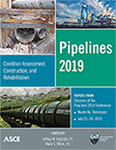Pipelines 2019
City of Baton Rouge: Integration of Condition Assessment Information Systems
Publication: Pipelines 2019: Condition Assessment, Construction, and Rehabilitation
ABSTRACT
Pipeline inspection management, maintenance management, and asset management tools come in multiple flavors, and with them, multiple data formats containing asset-related information. Not all these tools can be easily integrated with each other or with geographical information systems (GIS), which is essential for asset mapping. Without GIS integration, data visualization and analysis to prioritize asset conditions and to develop a rehabilitation plan is extremely challenging, especially when the information is contained across different networks. The focus of this paper is to describe how the system condition risk enhanced assessment model (SCREAM)—an advanced condition assessment tool—and feature manipulation engine (FME) tools were integrated with GIS to assist the city of Baton Rouge/Parish of East Baton Rouge (C-P) with their SSO program to help manage field inspections. The goal being to help close the “Inspection to Work Order Cycle” and get repairs addressed quicker, allowing engineers to focus on the engineering side of things instead of spending time sorting through data. Additionally, this paper will show how to leverage ESRI’s platform to visualize condition assessment information though GIS using web-based data dashboards. A tool was developed to automate data quality assurance using FME to audit the sanitary sewer evaluation survey (SSES) and to provide a detailed list of SSES Pipeline assessment certification program (PACP) errors. This list of errors helps contractors identify issues that need to be fixed so that their submittals can be accepted as delivered, rather than going through iterations that can take anywhere from a few days to 2 months. These accepted submittals are then loaded into SCREAM for analysis and reporting. C-P used SCREAM, their asset management tool, to score, prioritize, and make recommendations based on Baton Rouge’s CCTV data. SCREAM’s first module, scoring, calculated inspection scores (maintenance, structural, I/I, and total). SCREAM’s second module, next step, incorporated the asset inventory, inspection logs, risk scores, work order history, and several logic tables to determine the appropriate next maintenance and structural actions for the assets. Then, SCREAM costing calculated the costs of repairs, replacement, rehab, and continued maintenance over time and chose the optimal methodology for addressing the utilities’ priority assets. The last step was to integrate the results with GIS. FME spanned networks and imported SCREAM results into the GIS environment. FME provided a flexible environment to configure and deploy monthly email notifications that a utility’s management team can use to track data quality and to generate pipe inspection work orders. Armed with information that was quality controlled by FME and processed by SCREAM scoring, next step, and costing, Baton Rouge can create re-inspection, maintenance, and rehabilitation plans.
Get full access to this article
View all available purchase options and get full access to this chapter.
Information & Authors
Information
Published In
Pipelines 2019: Condition Assessment, Construction, and Rehabilitation
Pages: 51 - 59
Editors: Jeffrey W. Heidrick, Burns & McDonnell and Mark S. Mihm, HDR
ISBN (Online): 978-0-7844-8249-0
Copyright
© 2019 American Society of Civil Engineers.
History
Published online: Jul 18, 2019
Published in print: Jul 18, 2019
Authors
Metrics & Citations
Metrics
Citations
Download citation
If you have the appropriate software installed, you can download article citation data to the citation manager of your choice. Simply select your manager software from the list below and click Download.
